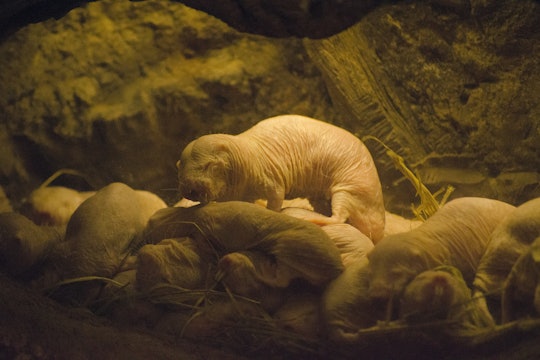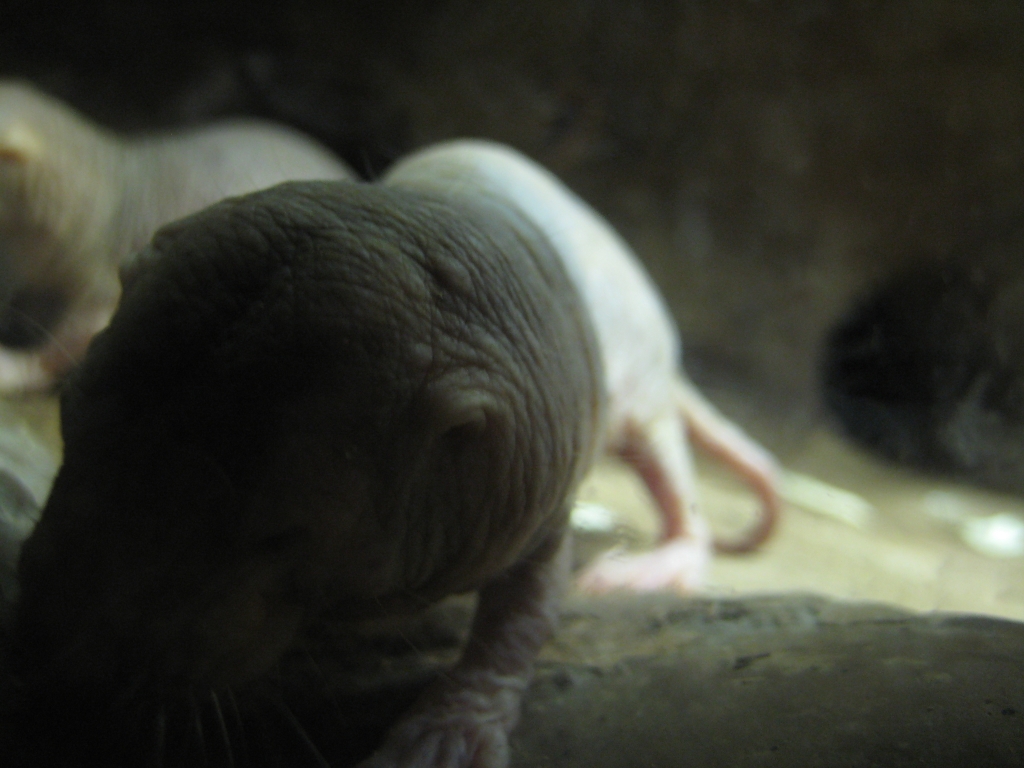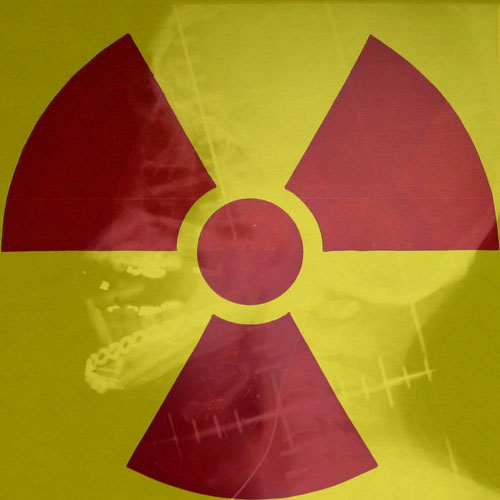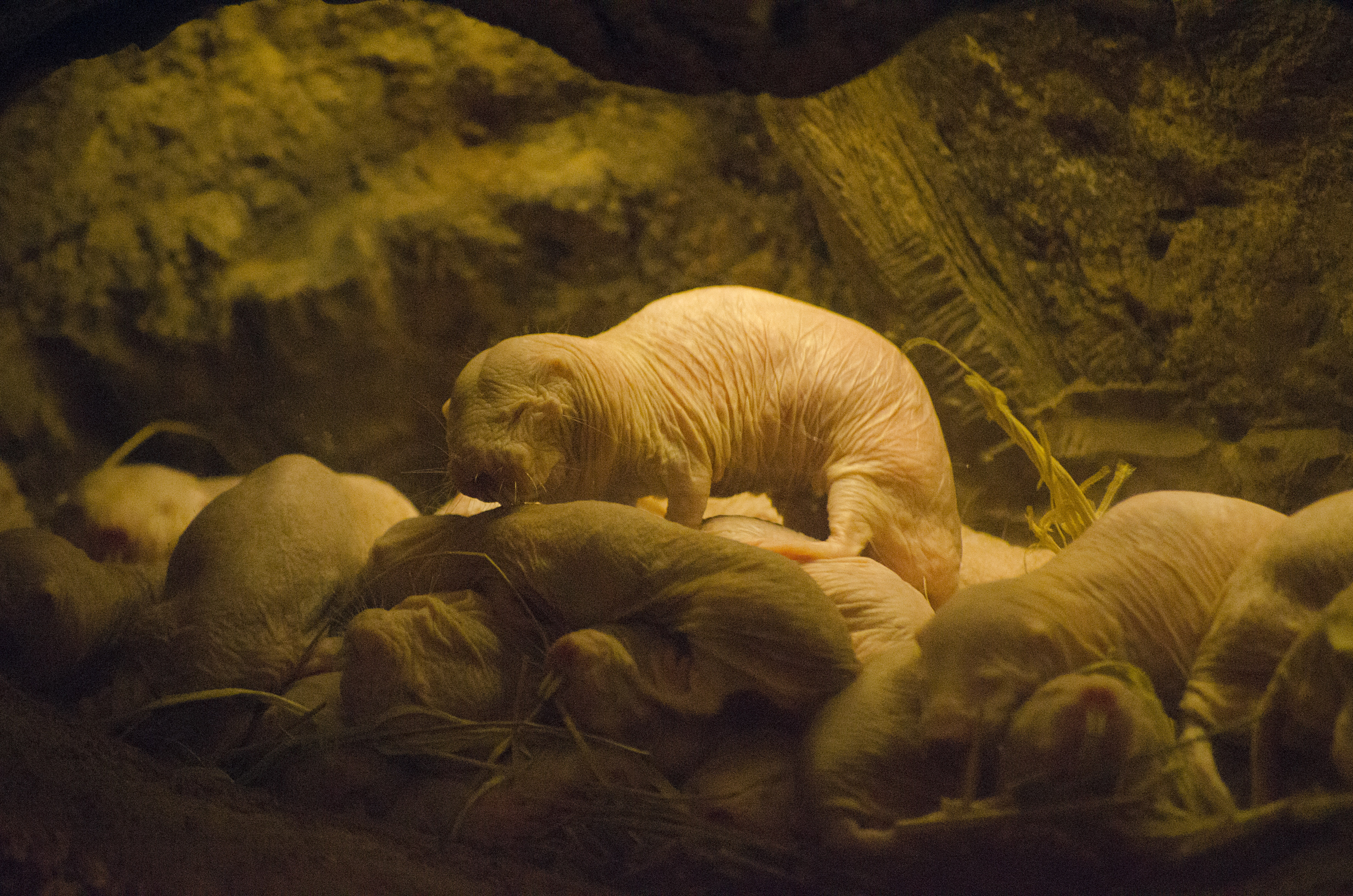
Theron Trowbridge / Flickr
Do naked mole rats hold the answers to cancer prevention and aging?
Their genes don't create faulty cells the way ours do
Naked mole rats are not winning an animal beauty contest any time soon. Eduard Rüppell, the German naturalist who discovered them, thought they were a diseased and mutated form of a different animal. Their hairless, wrinkly skin can bear a passing resemblance to a certain part of the male anatomy – so much so, the Canadian Centre for Child Protection once used naked mole rats in an anti-sexual extortion campaign. Outside their duty as protectors against sexual predators, though, naked mole rats may have the ability to help us live longer and healthier lives.
Naked mole rats were introduced to popular culture in the early-2000s by the Disney show Kim Possible – through a lovable pet named Rufus – but to understand the true impact of these animals, we must backtrack a bit further. In 1987, over two decades before the show premiered, the first naked mole rat (NMR) zoo colony was established in London. A few scientists were hired by the London Zoo to care for the animals and study their behavior. After a few years, these researchers noticed something odd: none of the animals were dying. An animal of the mole rats' size should live a maximum of five or six years, but some of the animals in the colony were well past that age.
Naturally, this generated an interest in NMRs beyond behavior. As studies in NMR longevity progressed, researchers noticed another oddity: no tumors developed, even among older NMRs. Cancer and aging are closely related – as we get older, our cells find it more challenging to repair damage, and accumulation of this damage leads to cancer development.
One way to combat this is cellular "senescence," which is when cells halt all growth (officially deemed cell-cycle arrest) and their associated cellular processes (such as DNA replication). When it comes to cancer, senescence prevents damaged cells from replicating and creating more faulty cells; however, it can lead to additional problems associated with aging, such as chronic inflammation that afflicts joints. Naked mole rats, it appears, have evolved a kind of senescence that may minimize some problems of aging.
Age, stress, and cancer
Last year, a group of researchers from around the world, led by Vera Gorbunova and Yang Zhao, set out to study various types of senescence in NMRs. They focused on three different types of senescence: developmental, which controls which cells remain “active” and dividing when embryos develop; oncogene-induced, which is caused by an overactive oncogene (a gene that leads to tumor growth); and stress-induced, which is often caused by outside factors, such as radiation. They faced a challenge of how best to study these mechanisms in an animal model that was relatively untested. The answer: precedence.

Megan / Flickr
Luckily for Zhao and his team, senescence is a well-researched area, especially in mouse models. Two markers, senescence-associated β-galactosidase (SA-βG, an enzyme that appears to only function in senescent cells) and p21 (the protein that is known to "turn on" senescence), are easily detected in cell culture through microscope imaging. DNA replication is easily measured through a stain that integrates into newly synthesized DNA. Using this technique, senescent cells should have less of this stain, as they aren't making new DNA. Researchers also measured levels of DNA damage and apoptosis (programmed cell-death, which typically occurs after too much DNA damage). Past researchers have performed these experiments in mice, so they had a good set of control data to help explain unique senescent mechanisms that may have been associated with naked mole rats.
The first half of the paper published by Zhao and Gorbunova presents straightforward findings. Staining for SA-βG in intact NMR embryos showed the characteristic green color, indicating high levels of the enzyme, which matched the staining of mouse embryos from the same experiment under the same conditions. In addition, microscope images revealed similar SA-βG staining in various embryonic tissues from the two animals, as well as staining of p21. This led to the conclusion that NMRs do experience developmental senescence as their embryos grow.
Second, the team looked at oncogene-induced senescence. To do this, they forced cells to over-produce an oncogene, called HRasV12, in naked mole rat and mouse cells. This activation of HRasV12 caused an increase in the enzyme SA-βG, as well as a decrease in DNA replication in both model systems. Interestingly, the naked mole rat cells showed similar levels of SA-βG staining when compared to mouse cells, but there was a smaller decrease in DNA replication in their cells.
This means that while the SA-βG enzyme is functioning at similar levels, naked mole rat cells do not inhibit DNA replication to the same degree as mouse cells. There are no clear indicators for why, and it sets up an interesting question for future studies. Regardless, the SA-βG staining led the researchers to conclude that NMRs do indeed undergo oncogene-induced senescence.
Radiation control
This is where the research started to pick up steam. To analyze stress-induced senescence, NMR and mouse cells were subjected to two levels of gamma radiation, 10 Gy (the unit of radiation) and 20 Gy. As expected, SA-βG staining was elevated in all cells upon exposure to gamma radiation. At 10 Gy of radiation, there was not much of an increase in senescence for naked mole rats (about a 10 percent increase). Comparatively, the mouse cells had a 25 percent increase in senescent cells – more than twice the amount as naked mole rats. Upon increasing the radiation level to 20 Gy, the number of senescent cells rose to match that of mouse cells. In other words, naked mole rats appear to have some extra defenses against low levels of radiation – perhaps a result of their underground habitat, but that remains to be confirmed.

Osman Parvez / Flickr
Following the radiation treatment, researchers also measured levels of apoptosis, the programmed cell-death that follows severe DNA damage. As radiation doses increase, we would expect apoptosis levels to do the same, as cells suffer from increasing DNA damage. In mice, this phenomenon was observed as expected. Naked mole rat cells, however, did not show increased apoptosis – even though the scientists discovered that the amount of DNA damage was the same in both naked mole rats and mice.
This finding is highly contradictory: higher DNA damage should induce higher levels of apoptosis. The research team conjectured that this is due to a stronger cell-cycle arrest response. Essentially, naked mole rats are better than mice at keeping their senescent cells from dividing and preventing them from being destroyed via apoptosis. This concept – that senescent cells aren't cleared away through apoptosis but rather remain functioning (yet non-dividing) – could be important in cancer prevention, since cell division is a main component of cancer in general. Which leads us to the big finale!
Regulated aging
In terms of their senescence mechanisms, the research team used RNA seq, a popular tool that allows us to analyze the expression of all genes in a given sample. This technique can provide a complete genetic picture that, when compared to a control, shows how different conditions affect specific genes. Using this, Zhao and colleagues could see which genes, and more importantly what related sets of genes, were altered following radiation treatment that induced senescence. Here they discovered perhaps the most important result of naked mole rat senescence – it is tightly regulated.
When analyzing mouse RNA seq data in the same manner, they noticed that gene expression changed randomly. There seemed to be no noticeable pattern of what genes were affected. Naked mole rats, on the other hand, are organized. Instead of randomly affecting genes, radiation of NMR cells caused regulation changes in whole genetic pathways, and in pathways that are vital to cell-cycle arrest and metabolic functions, among others. Essentially, naked mole rats have all the protection of senescence upon DNA damage, but they vastly reduce the negative side effects and better halt the growth of damaged cells.

This study raises a lot of potentially interesting and important questions. Why do NMR senescent cells not die, even with high levels of damage? How is the genetic regulation more organized in these cells? If we can start to answer these questions, naked mole rats could help us develop preventative therapies in cancer research.
Let me end on this final, important point: naked mole rats are incredibly strange animals, and we are just beginning to realize how unusual their biology truly is. NMRs don’t appear to feel any pain, a result of them missing an important neurotransmitter that transmits pain signals to the brain. These animals can survive without oxygen for up to 18 minutes, with absolutely no harmful side effects, by switching their metabolism to rely on energy created from fructose (a process that can be done without oxygen), instead of glucose (which requires oxygen to break down into energy we can use).
In case that isn’t amazing enough, breaking down fructose causes high levels of acid to accumulate in the body, which naked mole rats tolerate – how, we don't yet know. These wrinkly living sausages are so different from us that they could reveal secrets into natural cancer resistance, which we could use to make our own cancer prevention therapies. This study into senescence is just the beginning.
